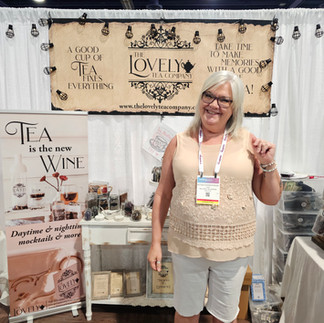Matcha Madness: A Recap of World Tea Expo 2025, Part 2
- Neldon Hamblin
- 8 hours ago
- 10 min read

Day Two: March 26th, 2025, "Matcha Madness"
I started out day two with a bang: I met Megan and Kelsey on the monorail and they shared an amazing canned matcha latte sample they had received from Wild Orchard. For being canned matcha lattes, sweetened with maple water, they were quite delicious. We then stopped by Wakoen’s tea booth, where they were serving up alcoholic tea beverages- I had the hojicha whiskey and while I wasn’t personally the biggest fan of that one, it was definitely a well-done drink. The whiskey definitely complemented the sweeter roasted flavors brought out in the production of hojicha. I then had some of Dethlefesen and Balk’s “tee-bären,” or tea gummy bears that could either be eaten as a tea-flavored snack, or dissolved in a cup of hot water to create a cup of tea. The flavor I had was their roasted almond, one of their most popular flavors. It was actually quite delicious- and the fact that these little bears could be dissolved into tea is amazing and incredibly innovative and fun.
I hit up the tea bar again for samples of the award-winning teas, but one of my real favorites that morning was the pink rose strawberry tea from Brook37. The color is incredibly vibrant and the flavor is lovely, being a nice blend of floral and fruity notes from the roses, strawberries, and elderflowers used in the blending of this tea. After the tea bar, I decided to spend some time in the Japanese tea section, sponsored by Tea Capital Shizuoka, who brought over 10 different Japanese booths to showcase Japanese teas. They were also the sponsors of the opening ceremony for day one. I saw Kanehachi Tea and sampled their different cold brewed teas, from hojicha to wakoucha (Japanese black tea) to cold brewed matcha. Their wakoucha was delicious- the real star was their delicious matcha hard candy, too, which had a lovely tea flavor without being overly sweet. Next up was Matsushita Tea Garden, who had delicious sparkling bottled teas for sample. I tried their bottled sparkling ume matcha as well as the sakura kocha, which were fascinating. It was unlike anything I had ever tried before- the sparkling tea had a unique mouth feel with the carbonation, but the flavors remained intact and unchanged, unlike with nitro brewing tea, where the flavors change. It was incredible.
One of the things I really loved about the Japanese tea section, aside from seeing familiar favorites like Marumatsu Seicha, was learning about Japanese tea culture more in-depth. Japanese teas are ones I am much less familiar with but I will be exploring more this year thanks to the great connections made with the various vendors- I especially enjoyed hearing about Tea Capital Shizuoka’s efforts to organize tea-tours to showcase the beauty of their prefecture while also showing the local tea industry. In fact, at Kanehachi Tea, I was informed that Shizuoka prefecture has recently opened a research facility dedicated to tea sciences, including developing and maintaining tea plants, creating new varieties, and studying existing ones more in-depth, as well as addressing the matcha shortage Japan is experiencing. It was so cool that I was able to learn more about their unique culture and see just how different it is from the Chinese tea culture I am used to.
Sticking to the theme, I then went to a guided tea tasting at Sugimoto Teas, held by Julia, a longtime friend of mine and one of the nicest people I’ve ever met. We tasted their single-cultivar Kamairicha Yabukita, a rare Japanese pan-fired green tea. This was fascinating as it’s essentially a Japanese green tea but made in the style of a Chinese green tea, where the leaves are pan-fried rather than steamed during processing. It was fascinating- it almost reminded me of a Japanese oolong in flavor characteristics, with a nice blend of floral and fruity flavors with a savory umami base. The best way I could describe it would be if there were such a thing as Japanese dragonwell tea (longjing)- it was nutty and slightly roasty, with a thicker, buttery body and a depth of sweetness to it. It’sso unique- it doesn’t feel like a Chinese green tea, but it also doesn’t feel like a Japanese green tea, either- it’s like the best of both worlds.
After the Japanese teas, I ran into the great team of So Gud teas, where I was able to spend a good bit talking with their founder and CEO, Ashanti Amasuriya. She actually had stopped me to take a picture as she follows my instagram and blog, which was so much fun! Ashanti is incredibly passionate about sustainability and driving change in the industry with sustainable, plastic-alternative packaging. Ashanti started So Gud with the goal of creating high-quality ready-to-drink beverages in “microplastic-free, compostable bottles designed for health and eco-conscious families.” For those who might not know, I used to work for the UNA-USA as a climate science blogger and educator, so sustainability has always been a key passion and interest of mine. In an industry like tea, sustainability is key to the future- and So Gud aims to play an integral role in this future. Their packaging for their ready-to-drink teas is 100% compostable and plant-based, being made of sugarcane, but you would never have guessed that. The material they use feels so incredibly close to plastic that I would never have known it were compostable and plant based rather than petroleum had they not included that in their packaging. This unique sugarcane packaging is also used for their cartons of tea sachets. It is incredible and definitely a game changer in ready-to-drink packaging for the market.
I tried each of their teas, starting with the passion fruit ceylon black tea, which was deliciously fruity and refreshing. They use natural ingredients in their teas, including cane sugar and monk fruit sweetener and refrain from adding artificial colors, flavors, or excessive sugar to their teas. I then tried their blue butterfly, a Sri Lankan butterfly pea flower herbal tea sweetened with stevia and monk fruit. This one was incredibly floral and had a nice, subtle sweetness to it. Next on their line was the hibiscus bloom tea (a blend of hibiscus, apple, rosehip, raspberry, and strawberry), and then their silver tips, a single-garden Sri Lankan white tea. This was one of my favorite white teas from the entire expo- it was incredibly light and balanced with a pleasant grassy sweetness to it, as well as a nice spicy note that one expects from a nice silver needle. I really enjoyed their booth and it is clear that they care about quality and the planet with their brand and I was grateful to have spent some time talking with them.
After having tried their teas, I went back to WuyiStar’s booth. I had been invited by the Chief Brand Officer, Jiadao, to do a livestream tasting session with my followers. You can watch the full livestream recap here. This was really a once-in-a-lifetime opportunity and I’m glad I was able to invite some of my closest friends, like Megan, Kelsey, and Shaelynn, to share this with me. Hearing their thoughts on wuyi yancha, being teaheads who weren’t as familiar with the category, was so much fun. I loved seeing just how much tea can connect us to others- this tasting really showcased how cultural connections over tea can transcend linguistic and geographic boundaries, and for a moment, it transported us all to the beauty of WuyiShan as we tasted the delicious hongyun dahongpao together. I then did another quick livestream walk around the expo, which can be found here. I was able to make dian cha with XH Life Tea, who were kind enough to give me a shot. Dian cha is essentially the ancient Song dynasty art of brewing tea- it would influence the Japanese tea ceremony and become the main method of preparing matcha. This historic method involves whisking ground tea into a frothy foam, then drawing on the foam with water to create beautiful designs. I was great at whisking, but not so much at drawing. Here is what I ended up drawing on my attempt. It was so much fun and I am so glad I was able to show you all the expo and the ancient art of dian cha.
The next booth I stopped by was ChiCha tea, also known as Waynes Tea Inc. ChiCha is another company dedicated to sustainability in their packaging, as well as animal rights and welfare (donating 1% of all their profit to different organizations that care for pets and animals). Their teas were delicious, especially their LaoMan’E shou puerh. What really fascinated me about their booth though was their milk tea. They had a tieguanyin milk tea as well as a dragonwell milk tea- but the dragonwell milk tea included their house-made boba pearls, which were unlike any others I’d had before. These boba pearls had barley in them! The taste was quite balanced as well- never in my life would I have considered adding milk to a tea like tieguanyin, or something like dragonwell, but it actually worked great. I have long thought that milk tea is a great way to introduce a wider audience to more pure-teas and this definitely proved that. It was a fun experience.
The last booths I visited were Tea For Guys, Katu, for their yerba mate, and The Lovely Tea Company (another longtime friend of mine- Michele rocks). The team of Tea For Guys was incredibly friendly and passionate about their product and their blended teas, geared towards men’s health, were flavorful.
Katu offers Paraguayan yerba mate and it was a great pick-me-up. I especially enjoyed their KoJoi mate, a roasted mate- it would be a great alternative to coffee as it provides a relatively similar caffeine content (around 75mg for 8 ounces) without the crashing. The Lovely Tea Company was so much fun to chat with and their products are absolutely gorgeous. They have their teas packaged in pouches that look like mason jars- so cute.
The rest of the day was spent going to the remaining booths and making my purchases, taking photos with tea friends and fans (like the amazing Phil Holmans of World Tea House) and enjoying the euphoric feeling that always comes from attending the expo.
And of course, being the second day, I bought a lot of tea from the vendors, as they had different deals. I primarily got WuyiStar items as it's hard to come by in the US (though this is changing- keep an eye out for some local tea shops that will be selling their teas in their stock!) but I got a few other teas as well. I got some of their tea face masks and their tea facial soap as I am a skincare nut and love all things tea-related when it comes to skincare. All that aside, here is my day 2 haul photo with some great teas, samples, promotional material, and candies from Japanese vendors.

Final Thoughts
Overall, as always, the expo was amazing and I had such an amazing time hanging out with new friends and reconnecting with old ones. The emphasis on being cash-and-carry too was great, as in years past, vendors usually wouldn’t sell products until the second day of the expo; this year, each booth generally had a stock of their products for sale on the show floor both days, allowing you to not feel like you had to make a decision on the spot or get buyers’ remorse for missing out on a product. I came home with some great goodies and made some wonderful connections in the industry and can honestly say that this year was the most successful World Tea Expo I’ve ever been to in terms of business connections.
I also fortunately had the chance to talk with some of the expo officials, like Ellainy Karaboitis-Christopoulos, the Business Development Manager of Questex, which was great. The amount of work she and the rest of the World Tea Expo team put into putting on this expo each year is impressive, and this year was certainly no exception. Questex also continues to listen to our feedback in the industry and make the expo bigger and better each year- I can tell that they genuinely do appreciate us as attendees and that they value our opinions and feedback.
Having the World Tea Expo slightly separated from the Bar and Restaurant side of things was also a bit of a breath of fresh air- several vendors had mentioned that they also enjoyed the feeling at this year’s expo as they felt like they had a bit more space for their booths and were able to connect better with customers and other industry officials. The variety of vendors was also impressive compared to years past. I saw a lot more premium Chinese tea brands, Nepalese tea brands, and Indian tea brands than in years past, and the expo floor felt like it had a much better coverage of the industry than previously. Interestingly enough, while previous years had focused on the boba tea boom, I would say that if there was a theme this year, it would be “Matcha Madness” due to the sheer amount of matcha present. This is a great thing, though, as the matcha industry has exploded in the US in recent years, which proves to me that the World Tea Expo has its finger on the pulse of the industry and is reflective of market conditions and demands. Now, I had heard from some of the vendors that friends of theirs had issues with obtaining travel visas, so there were some empty spaces, but even through this, the expo managed to shine at showcasing the diverse world of tea. I also loved that the opening ceremony this year focused more on tea and tea culture than in years past. However, I will say that the one drawback of having it on its own floor away from the bar and restaurant expo is that a lot of the tea people tended to stay upstairs and avoided venturing downstairs to see the bar and restaurant side of things. Overall, it was a great blend of bar and restaurant culture and tea culture, though, and I would say that for future opening ceremonies, having both a bit explaining about the bar and restaurant expo and then a bit on the tea side of things is a great way to go. I personally heard many comments from people during the opening ceremony about how cool the performance of “Sukiyaki” was from Reiko. Having Tea Capital Shizuoka sponsor the ribbon cutting and opening ceremony for the tea expo was a great move and made for a truly memorable experience.
The World Tea Expo is such a great representation of the importance of community and friends in the world of tea- making new connections with others and reinforcing existing connections is such a great thing. The tea industry continues to thrive despite challenges thrown its way and I do still maintain that community and a sense of inclusivity in the world of tea are what help it thrive- both of these being qualities on full display at the World Tea Expo. I look forward to seeing you all again at the World Tea Expo 2026, which will be held March 23rd-26th, 2026 at the Las Vegas Convention Center.
Thank each and every one of you for your continued support- without it, I would not have had the opportunity to attend the expo so many years ago. As a kid from rural northern Utah, I could never have dreamed that I would be able to attend such an incredible event, let alone make so many great friends and connections annually. Thank you all so much for your support and for everyone I saw at the expo for making it such an amazing experience. Cheers, friends!




























































